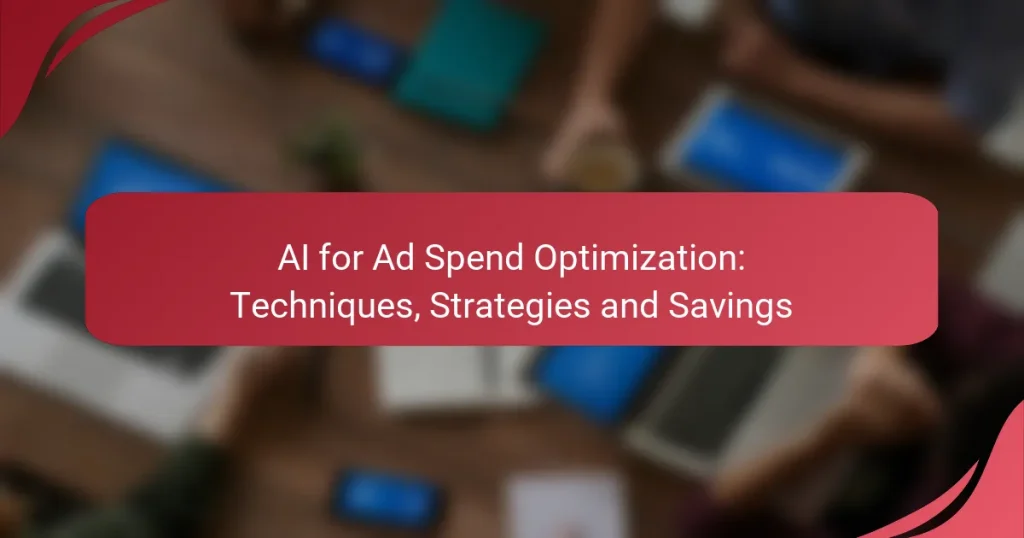Artificial Intelligence (AI) plays a crucial role in optimizing ad spend by analyzing extensive data to inform budget allocation and campaign strategies. By employing techniques such as machine learning for ad placement and natural language processing for ad copy, businesses can enhance their advertising efficiency and maximize return on investment. Implementing dynamic budget reallocation and customer segmentation further ensures that resources are effectively targeted, leading to significant savings and improved campaign performance.

How can AI optimize ad spend in e-commerce?
AI can significantly enhance ad spend optimization in e-commerce by analyzing vast amounts of data to make informed decisions on budget allocation, targeting, and campaign adjustments. This leads to improved return on investment (ROI) and more efficient use of advertising budgets.
Predictive analytics for budget allocation
Predictive analytics uses historical data to forecast future trends, helping e-commerce businesses allocate their ad budgets more effectively. By identifying which products or campaigns are likely to perform well, companies can direct funds toward high-potential areas, maximizing their advertising impact.
For example, if data indicates that certain products see higher sales during specific seasons, businesses can increase their ad spend in anticipation of these trends. This approach can lead to savings of 10-30% by avoiding wasteful spending on underperforming ads.
Real-time bidding adjustments
AI enables real-time bidding adjustments by analyzing performance metrics and market conditions instantly. This means that e-commerce platforms can modify bids based on competition and ad performance, ensuring optimal placement without overspending.
For instance, if a keyword suddenly becomes more competitive, AI can automatically increase the bid for that keyword to maintain visibility. Conversely, if a keyword is underperforming, the system can reduce the bid, thus conserving budget for more effective ads.
Automated audience targeting
Automated audience targeting leverages AI to identify and reach the most relevant customers based on their behavior and preferences. This targeted approach reduces ad spend by focusing on users who are more likely to convert, rather than casting a wide net.
Using machine learning algorithms, e-commerce businesses can segment audiences and tailor ads accordingly. For example, targeting users who have previously purchased similar products can increase conversion rates significantly, leading to a more efficient use of advertising resources.
Performance forecasting
Performance forecasting involves predicting the outcomes of ad campaigns based on various factors such as historical data, seasonality, and market trends. AI tools can analyze these elements to provide insights into expected performance, allowing businesses to make data-driven decisions.
By understanding potential ROI before launching a campaign, e-commerce companies can adjust their strategies or budgets accordingly. This proactive approach helps in avoiding costly mistakes and ensures that funds are allocated to the most promising campaigns.
Campaign optimization algorithms
Campaign optimization algorithms continuously analyze ad performance data to identify the best strategies for maximizing effectiveness. These algorithms can adjust various parameters, such as targeting, bidding, and creative elements, in real-time to enhance overall campaign performance.
For example, if an ad is not meeting performance benchmarks, the algorithm can automatically test different headlines or images to find more effective combinations. This iterative process can lead to significant improvements in conversion rates and reductions in cost per acquisition (CPA).

What techniques improve ad spend efficiency?
Techniques that enhance ad spend efficiency include leveraging machine learning for ad placement, utilizing natural language processing for ad copy, and implementing data-driven decision making. These strategies help optimize budget allocation and maximize return on investment.
Machine learning for ad placement
Machine learning algorithms analyze vast amounts of data to determine the most effective ad placements. By evaluating user behavior, demographics, and engagement metrics, these systems can predict which placements will yield the highest returns.
Consider using machine learning tools that automate bidding strategies based on real-time performance data. This approach can lead to cost savings of 10-30% compared to traditional methods, as it continuously adjusts bids to optimize ad visibility.
Natural language processing for ad copy
Natural language processing (NLP) enhances ad copy by analyzing language patterns and consumer sentiment. By understanding what resonates with target audiences, businesses can create more compelling and relevant advertisements.
Utilize NLP tools to generate variations of ad copy and test their effectiveness. A/B testing different versions can improve click-through rates by 20-50%, ensuring that the most effective messaging is used in campaigns.
Data-driven decision making
Data-driven decision making involves using analytics to guide advertising strategies. By tracking key performance indicators (KPIs) such as conversion rates and customer acquisition costs, marketers can make informed adjustments to their campaigns.
Establish a regular review process for your ad performance data. This should include analyzing trends and identifying underperforming ads, allowing for timely adjustments that can enhance overall campaign efficiency and effectiveness.

What strategies maximize ROI on ad spend?
To maximize ROI on ad spend, businesses should implement strategies that enhance efficiency and effectiveness in their advertising efforts. Key approaches include dynamic budget reallocation, cross-channel integration, and customer segmentation strategies, each designed to optimize resource allocation and target the right audience.
Dynamic budget reallocation
Dynamic budget reallocation involves adjusting advertising budgets in real-time based on performance metrics. This strategy allows marketers to allocate more funds to high-performing campaigns while reducing spend on underperforming ones, ensuring optimal use of resources.
For instance, if a particular ad on social media is generating significantly higher engagement compared to a search engine ad, reallocating budget towards the social media campaign can enhance overall ROI. Regular monitoring and quick adjustments are crucial for success in this approach.
Cross-channel integration
Cross-channel integration ensures that advertising efforts across various platforms work cohesively to deliver a unified message. By synchronizing campaigns on social media, search engines, and email, businesses can create a seamless customer journey, enhancing brand recognition and engagement.
Using tools that track customer interactions across channels can help identify which platforms yield the best results. For example, integrating data from Google Ads and Facebook Ads can reveal insights into audience behavior, allowing for more targeted and effective ad placements.
Customer segmentation strategies
Customer segmentation strategies involve dividing a target audience into distinct groups based on shared characteristics, such as demographics, behaviors, or preferences. This allows for tailored advertising that resonates more effectively with each segment, improving engagement and conversion rates.
For example, a business might segment its audience into categories like age groups or purchasing habits, then create specific ads that appeal to each group. This targeted approach can lead to higher ROI as ads become more relevant to the viewers, reducing wasted spend on uninterested audiences.

What are the key metrics for measuring success?
Key metrics for measuring success in ad spend optimization include cost per acquisition (CPA), return on ad spend (ROAS), and click-through rate (CTR). These metrics provide insights into the effectiveness and efficiency of advertising campaigns, helping businesses make informed decisions about their marketing strategies.
Cost per acquisition (CPA)
Cost per acquisition (CPA) measures the total cost of acquiring a customer through advertising. It is calculated by dividing the total ad spend by the number of conversions, providing a clear picture of how much each new customer costs. Keeping CPA low is crucial for maintaining profitability.
To optimize CPA, focus on targeting the right audience and refining ad creatives. Regularly analyze which channels yield the lowest CPA and adjust budgets accordingly. Aim for a CPA that aligns with your customer lifetime value to ensure sustainable growth.
Return on ad spend (ROAS)
Return on ad spend (ROAS) indicates the revenue generated for every dollar spent on advertising. It is calculated by dividing total revenue from ads by the total ad spend. A higher ROAS signifies more effective ad campaigns, making it a vital metric for evaluating performance.
To improve ROAS, consider testing different ad formats and targeting strategies. Monitor performance closely and shift resources to the most effective campaigns. A good benchmark for ROAS is typically around 4:1, meaning for every dollar spent, four dollars in revenue should be generated.
Click-through rate (CTR)
Click-through rate (CTR) measures the percentage of users who click on an ad after seeing it. It is calculated by dividing the number of clicks by the number of impressions. A higher CTR indicates that the ad is engaging and relevant to the audience.
To enhance CTR, focus on crafting compelling ad copy and using eye-catching visuals. A/B testing different headlines and calls to action can help identify what resonates best with your audience. Generally, a CTR of 2-5% is considered good, but this can vary by industry.

How to choose the right AI tools for ad optimization?
Selecting the right AI tools for ad optimization involves assessing their capabilities, compatibility with your existing systems, and the specific needs of your advertising strategy. Prioritize tools that offer robust analytics, automation features, and adaptability to various ad platforms.
Evaluating software capabilities
When evaluating software capabilities for ad optimization, focus on features like predictive analytics, real-time bidding, and performance tracking. Look for tools that can analyze large datasets quickly, providing insights that help refine targeting and budget allocation.
Consider the user interface and ease of use, as a more intuitive platform can save time and reduce errors. Additionally, check for customizable reporting options that allow you to tailor insights to your specific goals.
Integration with existing platforms
Integration with your current advertising platforms is crucial for seamless operations. Ensure that the AI tool can easily connect with systems like Google Ads, Facebook Ads, or programmatic platforms to streamline data flow and campaign management.
Evaluate the support for APIs and data import/export functionalities, which can enhance interoperability. A tool that integrates well can significantly reduce manual work and improve the accuracy of your ad campaigns.


